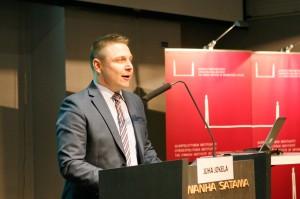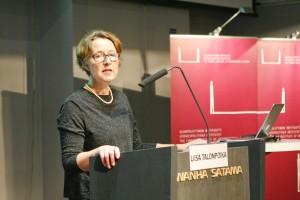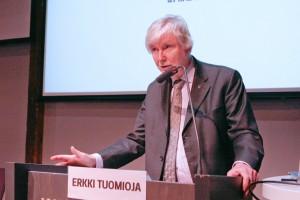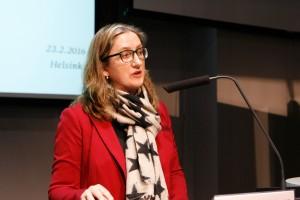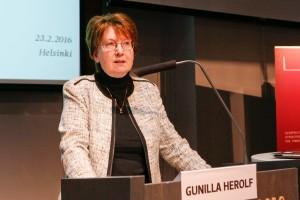EU’s enlargement and ongoing multiple crises have increased differentiation in European integration. This, in turn, has highlighted the potential embedded in the Nordic cooperation in EU affairs. Yet the EU’s differentiation is forcefully manifested also in the Nordic region. While Finland is the only Nordic member of the Euro area, Iceland and Norway remain outside the EU; yet they are closely attached to it through membership in the European Economic Area and Schengen Area. What are the key challenges and opportunities the EU and its development presents for the Nordic cooperation? How to strive for more Nordic synergy in the EU?
Opening words:
Liisa Talonpoika, Director General at the Department for Europe, Ministry for Foreign Affairs of Finland
Speakers:
Erkki Tuomioja, Member of Parliament, the Parliament of Finland
Helle Engslund Krarup, Senior Adviser, Office of the Secretary General, Nordic Council of Ministers
Gunilla Herolf, Member, Swedish Royal Academy of War Sciences
Chair:
Juha Jokela, Programme Director, the Finnish Institute of International Affairs
The speech of MP, PhD Erkki Tuomioja:
FIIA seminar 23.2. 2016 Helsinki
Two things stand out as the defining features of the Nordic Region in other peoples’ and other countries’ perceptions.
One is the fact that the five Nordic countries are almost always among the top ten or close to it in all the international beauty contests where all countries in the world are regularly ranked according to their achievements in education, gender equality, environmental care, social welfare, lack of corruption, good governance, competitiveness or even the happiness of the population.
Behind these achievements the rest of the world sees something called the Nordic Model of a welfare state. Interestingly, it was the outside world and not the Nordics themselves who first began using the concept. The Nordic countries never intentionally planned something they would call the Nordic model and almost all the main features in the model were adopted and implemented in the Nordic countries in mostly parallel processes in which the countries took their decisions independently of each other. Nevertheless they arrived in solutions which looked from the outside were remarkably closer to each other than to any in the rest of the world.
Only later on did the Nordic countries start to refer to the Nordic model which is now a standard or indeed obligatory part of the rhetoric used at the Nordic Council, for example.
The second Nordic feature is the perceived role of the Nordic countries in international affairs. Here again the similarities override their differences vis-à-vis non-alignment and Nato and vis-à-vis their sovereignty and the EU. As small trading economies they are all dependent on and committed to free trade and open borders and they have a strong interest in supporting a multilaterally agreed rules-based world order.
I am very happy to have these as the defining features of the Nordic countries profile both in the EU and the world at large. I do, however, have to put the question whether this profile can be maintained and is it being eroded today.
Take the Nordic model. While the Nordic countries standings in the myriad ratings have not significantly weakened there is a clear trend towards introducing reforms based on neoliberal market-oriented ideas involving privatisation, outsourcing and cuts in welfare benefits and services. This has had the predictable result of introducing more inequality to the Nordic countries. The success of the Nordic model in result-delivering cooperation between the labour market looks also being threathened.
At least as worrying and more damaging for the Nordic image is the erosion of their reputation as impeccable multilateralists showing the way for the rest of the world in global responsibility. Denmark has led the way in introducing more and more stringent rules for asylum-seekers with an unabashedly clearly formulated message, that refugees are NOT welcome to the country. The official rhetoric in Denmark too has been that refugees should be helped closer to their former homes and that the issues driving people to leave their homes should be settled with effective international cooperation. This rhetoric notwithstanding the reality has been that the main instrument for doing this i.e. development aid has been cut form 0,89 % of GNP to 0,7 %.
In response to the unexpected surge that brought over 30 000 asylum seekers to Finland last year attitudes in our country have hardened as well and brought out an unprecedented increase in open hate speech and violence directed against asylum seekers and indeed all foreigners, but also a groundswell of solidarity with thousands of people signing up for volunteer work at reception centres for refugees. Correspondingly we have seen a polarization of opinion in our country too.
With a right-wing populist anti-immigration party in government whose rank and file demand closed borders the Finnish government been obliged to chart a difficult course maintaining its lip-service to European values openly disregarded by one party. This refers not only to immigration but also to how to react to EU members states openly violating democratic and rule-of-laws standards. The easiest part for the government has been to slash development aid by 40 percent.
Norway and Sweden have also been forced to change policies. The proposed cuts in development aid were rejected by Norwegian stortinget, but Norway and even more spectacularly Sweden have made almost a U-turn in their asylum-policies, reintroducing border controls and tightening vetting procedures. To be fair this has to be seen against the background that Sweden has been the only EU country which is among the top 10 countries in the world taking refugees in proportion to its population. (The other countries that bear the most responsibility for hosting refugees are much poorer than the EU-countries.)
I have wanted to begin my remarks with these observations to put the question on what actually is it that the Nordic countries can and wish to offer to their partners in the European Union and what is it that these partners are interested in. I assume, that the interest is still focused on the Nordic model and the contribution that the Nordic countries can give to multilateral cooperation, conflict resolution and crisis-management to strengthen democracy, rule-of-law, inclusive development, gender equality and respect for Human Rights, and I do hope that the Nordic countries will continue to be able and willing to deliver on this.
The Nordics in the EU
The Nordics have not wanted to form a bloc in the EU. They tend to frown on other countries bloc building, such as the (now relatively weakened) Franco-German axis, or the recent convening of the six original EEC founding states or any other combinations that have the potential to impose their views and proposals on others, which obviously neither the Benelux, Visegrad or Nordic countries have.
It is also obvious, that the Nordic countries are all dismayd by the prospect of Britain exiting from the EU, even if they do not have a bloc-relationship with the UK.
Moreover the Nordic group comprises of five countries of which two, Iceland and Norway, remain outside the EU. The three EU countries have a slightly dissimilar position with Finland being the only country in the Eurozone and Denmark retaining some specific opt-outs. The three Nordic countries very rarely have any common meetings on EU issues preferring to hold NB6 meetings with the three Baltic countries ahead of each FAC meeting. Mostly they involve an exchange of views and comments without a single example of coming out with an explicitly common position to be presented at the council.
In view of the Nordic countries image and profile it is actually somewhat surprising that they have not sought to put forward a common programme or even a coordinated approach on an issue-by-issue basis. Of course the Nordics are seldom in any opposition to each other and find themselves sharing more or less the same positions without prior coordination. Usually, but not always as there are differences on Common Agricultural Policy for example. Happily even rarer are the instances of where Nordic interests directly collide in the EU.
Could and should there be more active input and coordination? I would answer in the affirmative. I think the Nordic countries could do more to promote the Nordic approach to gender equality, universal education, inclusive social policies, labour market practices, good governance and transparency and other features central to the Nordic Model. This is something that the Nordics actually do cooperate on, but mostly outside the EU, for example in regional cooperation in the Baltic Sea area and in many developing countries.
Even in the field of Defence, where the Nordic countries are split with three Nato and two non-aligned countries, the Nordics do cooperate through NORDEFCO also with outside partners in crisis-management operations and training security forces. And indeed NORDEFCO itself stands out as good example of the kind of pragmatic pooling and sharing that the EU as a whole is supposed to strive for.
The EU’s agenda is driven, in varying proportions, by the Commission and the biggest member states and of course events, to which each and all have to react. From time to time the EU bureaucracy puts forward proposals that are awkward for one or two or all three of the Nordic countries. Even when all three Nordic EU members share the same concerns it is sometimes difficult to see if they really do try to work together in a coordinated manner to stop or amend the proposals.
And if a proposal is viewed as involving a vital interest of only one Nordic country no attempt is usually made to engage the others to actively support the country in question even when there is no opposing interest in the neighbouring countries which would prevent them from solidarizing with the country concerned.
Obviously it has to be the governments and ministries concerned who are responsible for this kind of coordination. They are the ones who sit on the council and are represented in the numerous working groups where EU directives and decisions are shaped. In practice there are a lot of synergies between Nordic cooperation and the EU and EU-issues are regularly on the agenda of the Nordic Ministerial Council in all its formations. These can pertain to EU funding and many questions on EU legislation and on implementing EU-strategies.
The Nordic countries also have a very central role in the Union’s arctic policies, as the five Nordic countries are the only European members in the arctic Council. They should boldy take the lead in the EU on all arctic issues with the safeguarding of the vulnerable arctic environment as the primary concern which determines the rules for economic activities in the high north.
We do not need any new institutional arrangements but rather more effective Nordic networking where not only officials at all levels but also ministers when needed can pick up the phone and consult with their Nordic counterparts. This is what should have happened last summer when the refugee crisis with an influx of asylum-seekers to the Nordic countries took everyone by surprise and the immediate reaction was to take national action with little or no Nordic consultation or coordination initially.
One common feature of the Nordic EU-members is that they have the most effective and far-reaching systems for parliamentary scrutiny over all issues discussed and decided in the EU. This begs the question, are the parliaments sufficiently in touch with other to coordinate their views on EU-issues, and the answer is unfortunately no. During the two separate four year terms I have served as chairman of the Finnish parliament’s EU-affairs committee, the Grand Committee, I have to say that I am disappointed with how little we have achieved my repeated efforts notwithstanding in strengthening the Nordic Parliaments’ cooperation and coordination on EU issues.
Could the Nordic Council come to the rescue? It certainly is eager to do so. I recall how in the beginning of the nineties when Finland, Norway and Sweden were set to follow Denmark into the Union the Nordic Council become feverishly active in trying to carve out a central role for itself as the coordinator for the Nordic countries’ EU-policies. This was mostly an earnest attempt to make sure that there would be a strong Nordic voice in the EU, but it was also driven by a fear that with the focus moving to Brussels and the EU, the Nordic Council would be marginalized.
At the time I could not support this endeavour as I thought it both unrealistic and even detrimental if it tried to indirectly bypass the EU committees of the Nordic parliaments. EU policies cannot be coordinated in any rotating formula in the Nordic capitals; it is done by direct governmental cooperation and in Brussels. The necessary the parliamentary input has to come though the parliaments’ European affairs committees, which have the mandate and the resources to effectively follow and influence EU decision-making.
Once again there are proposals to strengthen the Nordic Councils’ role in EU-issues, including a proposal for opening an office for the Council in Brussels. I see this essentially as a repetition of the mostly futile exercise more than 20 years ago.
This is not to say that the Nordic Council should not follow and engage on EU issues. There are certainly issues – for example building on the experience of the Nordic countries avant-garde role in creating a Nordic citizens common space with free movement of people and goods, a common labour market, social security agreements etc. – where the Nordic council can make a valuable contribution, even if the immediate concern is to safeguard what we have achieved over the decades without moving backwards. The Nordic Council can be an effective instrument for channelling the interests and concerns of Iceland and Norway, who are equal partners in Nordic cooperation but lack a direct voice in Brussels.
But the actual parliamentary input to EU policies is the primary responsibility of the EU-committees, and if the Nordic Council can somehow enhance their coordination and cooperation that would be a welcome contribution.
It is also evident, that while the Nordic council can and should have contacts with the European Parliament and with the Nordic MEPs in the Parliament, here too the primary responsibility for this resides with the European Affairs Committees.
Summary of the seminar:
Director Liisa Talonpoika mentioned the Finnish presidency this year in the Nordic Council of Ministers and underlined the agenda of further Nordic cooperation in her opening remarks. She also noted that the topic of this event is very current in regards to the UK membership arrangements and the migrant discussion, and she also addressed the need to redefine the Schengen agreement and reassess the Dublin regulation. The changed security environment has also become a reality that affects the Nordic region and the principle of free movement between the Nordic countries. For the first time since 1958 there is now systematic border control between the Nordic countries.
Talonpoika stated that because of these developments there is a growing feeling among the Nordic countries for deeper cooperation, since ministers are meeting more frequently than ever. She finds two different perspectives within the work of the Nordic Council of Ministers. The first is to look at the current agenda: how can we perform better with the already existing tools, and the other one contains a longer future perspective where the question is how to impact and implement EU decisions within the Nordic Council of Ministers and between the countries.
Member of Parliament Erkki Tuomioja started his speech by crediting the Nordic countries for always being ranked in the top 10 in areas such as gender equality, education, low corruption and competitiveness. According to Tuomioja, these rankings are being achieved as a result of the Nordic welfare state model. He continued with the history behind the concept of the Nordic model, which started out as individual countries made their own decisions independently but came to resemble one another. It was not until later that the idea of a common Nordic model was recognized and used by the Nordic countries themselves. The question Tuomioja raised was whether this Nordic profile can be maintained. The welfare state profile has now been affected undesirably by the government cuts to social security and development aid which in turn are increasing inequality. The Nordic region is being affected by the refugee crisis and the outcome is a lack of global responsibility and a polarization of opinions, he argues. However, Tuomioja stated that the Nordic countries still should promote the Nordic model, including conflict resolution, crisis management, gender equality and the rule of law, to their European partners.
Regarding the Nordic cooperation, there can be seen a lack of a coherent coordinated profile. As an example he gave the management of the asylum crisis. Instead of consulting each other, the Nordic countries all took individual national actions to try to cope with the crisis. The focus should be put on strengthening already existing networks, not creating new institutions in the Nordic region. The Nordic countries have chosen not to have a bloc profile in the EU, but they do share the same kind of positions and it is rare for the Nordic countries’ interests to collide with the EU’s. The Nordic Council has shown initiative and a common profile on promoting Nordic values such as gender equality, but that has taken place outside the EU. That is why according to Tuomioja it is time for the Nordic governments and ministers to call for enhanced Nordic cooperation if the Council wants to have leverage in the EU. He also suggested that the Nordic countries should boldly take the lead in the EU regarding Arctic matters.
In Helle Engslund Krarup’s introduction, she underlined the importance of a common profile and cooperation for the Nordic countries to be in a stronger position to provide policy input to the European arena. The vision for the Nordic region expressed by the ministers for Nordic cooperation includes a borderless, innovative, internationally engaged and visible Nordic region. Krarup noted that during its presidency of the Nordic Council of Ministers this year, Finland has a focus on achieving more Nordic synergy in the EU, and the promotion of Nordic values. This direction is a very welcome contribution to the ongoing reform process within the Nordic Council of Ministers. In practice there is already widespread cooperation on EU matters in the 11 councils in the Nordic Council of Ministers. This cooperation ranges from discussions and exchange of information to concrete common initiatives towards central EU actors.
The Nordic Council of Ministers also functions as an arena to facilitate dialogue between the Nordic governments, to form deeper cooperation on EU matters. Furthermore the Nordic Council also provides funds and resources when the countries want to act together. A substantial contribution to the European work on biodiversity has been made by the Council of Ministers for the Environment. What started out as a Nordic Council funded initiative has now been lifted to EU level. It consists of a system of information exchange on species control and legislation. As another example Krarup mentioned the strategic analyses launch by the Minister Councils on Labour and Energy which look at future cooperation potential between Nordic countries in these sectors with a link to the EU’s policies. The analyses also provide concrete proposals for future Nordic cooperation in a 5-10 year term in these areas.
As previously mentioned, the Nordic Council of Ministers also functions as an actor when the Nordic countries want to act together. An example of this can be found in common declarations proposing new policies to promote Nordic values in the EU. In 2015 ministers for Labour and Social Affairs adopted common declarations directed to the EU Commission, to promote EU policies which do not undermine the Nordic welfare state model with regards to the coordination of the social security system and the labour mobility package. Krarup concluded with the current focus of the Nordic Council of Ministers which is to ensure that all the 11 minister councils are using the opportunities for cooperation in a more systematic manner and making sure that EU matters are put on the agenda of all ministerial meetings. Furthermore she sees a potential for deeper cooperation between the Nordic countries in the future.
Gunilla Herolf started her presentation by stating that we now find ourselves in a period of challenges, and that many of the previous positive developments have come to a halt. Globally, climate change is finally seen as a reality that has to be stopped or at least slowed down. The failed outcome of the Arab Spring, the desperate situation in Syria and the refugee crisis, as well as Russia’s actions in its neighbourhoods, only increase the challenges we are facing. Herolf pointed out that the EU is now faced with a new situation: the EU now has to deal with multiple crises at many different levels, including the financial crisis which still exists but tends to be somewhat forgotten. She also mentioned the Brexit issue which is going to have an effect on the whole of EU.
In contrast to many others the Nordic countries have been doing well. Herolf described the Nordic countries as modern competitive societies that see globalization rather as an opportunity than as a threat. Despite this fact and our solidly democratic societies, in today’s world no country is immune to surrounding threats. Herolf underlined the fact that the world is a complex integrated space and a country can be affected even though actions are not directed towards it.
Herolf also highlighted the fact the small size of the Nordic countries reaffirms the need for cooperation in order to have an impact on other regions and the EU. The member states and especially the Nordic countries have to stay active to get noticed by bigger countries and to have an impact. The Nordic region collaborates because of common interests, to increase efficiency and security, and to save money, but according to Herolf it is important that the cooperation does not become an isolated movement. The Nordic region must be open towards partners and other countries such as in the Baltic Sea region and not directed towards itself.
Herolf reminded of the fact that small countries need organizations. Bigger countries can to a higher degree manage on their own but for small ones the rules, structures and support that the EU gives us are essential.
However, the EU also needs us right now and we should do our best to support it. The refugee crisis has pitted member states against each other and the UK’s demands may well lead to similar demands by others and thus eternal negotiations and risk of serious destabilization. Furthermore, the worsening of democratic values in some EU member states has had a destructive effect on the EU’s profile. Due to this development, according to Herolf, it has become very problematic for the EU to demand these democratic values of freedom of speech, respect for the justice system and anti-corruption from the Balkan countries now seeking to join the EU, since we are not following them either.
The last point of Herolf’s presentation, and where we also need to help, described the disinformation campaigns that are directed towards Europe and which have the aim of destabilizing our societies. The worry extends especially towards the youth who now to an increasing degree receive their information via the social media. This is a serious concern that has been addressed in the EU and also by NATO, but according to Herolf should be given more attention.
This event was chaired by Dr. Juha Jokela who stated that the topic of the event is very timely since the EU is facing a lot of different challenges at the moment. Jokela brought up the question of the Nordic countries’ contribution to these challenges. He concluded by saying that cooperation already exists between the Nordic countries but there is also a need for further cooperation. He also suggested that the lack of current Nordic initiatives might be due to the need to quickly respond to the different crises the countries are facing, and because of this they do not have the resources to coordinate action between the Nordic countries.
